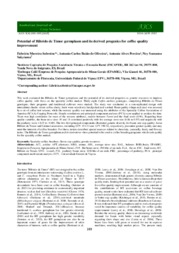Potential of híbrido de timor germplasm and its derived progenies for coffee quality improvement.
Potential of híbrido de timor germplasm and its derived progenies for coffee quality improvement.
Author(s): SOBREIRA, F. M.; OLIVEIRA, A. C. B. de; PEREIRA, A. A.; SAKYIAMA, N. S.
Summary: This work evaluated the Híbrido de Timor germplasm and the potential of its derivedprogenies as genetic resources to improve coffee quality,with focus on the specialty coffee market. Thirty eight Coffea arabicagenotypes, comprising Híbrido de Timor genotypes, their progenies and traditional cultivars were studied.The study was conducted in a non-replicated design with intercalated checksw here coffee cherry fruits were selectively handpicked and washed. Bean quality (shape and size) was assessed by a set of coffee test screens, while the sensory quality was measured using the attributes of the Specialty Coffee Association of America (SCAA)Cupping Protocols.Simple correlations and principal component analyes(PCA) were applied to analyze the data. There washigh correlation for most of the sensory attributes , mainly between flavor and the final score (0.96). Regarding bean quality variables, the beansieve sizes 19 and 18 correlated positively with the average sieve size (0.84 to 0.93) and negatively with the peaberry sieve (-0.55 to -0.69). The two first principal components illustrated genetic diversity for beans and cup quality. Some Híbrido de Timor and Catimor accessions, including UFV 454-43 and UFV 390-52, respectively, presented greater quality and may meet the interests of coffee breeders. For these, tasters described special nuances related to chocolaty, caramelly, fruity and flowery tastes. The Híbrido de Timor germplasm and its derivatives show potential to be used in coffee breeding programs which seek quality for the specialty coffee market.
Publication year: 2015
Types of publication: Journal article
Unit: Embrapa Coffee
Keywords: Bourbon, Cup quality, Flavor, Specialty coffee, genetic resources
Observation
Some of Embrapa's publications are published as ePub files. To read them, use or download one of the following free software options to your computer or mobile device. Android: Google Play Books; IOS: iBooks; Windows and Linux: Calibre.
Access other publications
Access the Agricultural Research Database (BDPA) to consult Embrapa's full library collection and records.
Visit Embrapa Bookstore to purchase books and other publications sold by Embrapa.

